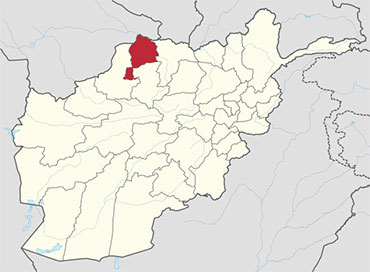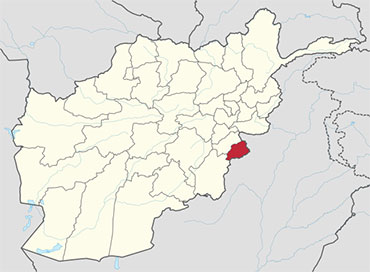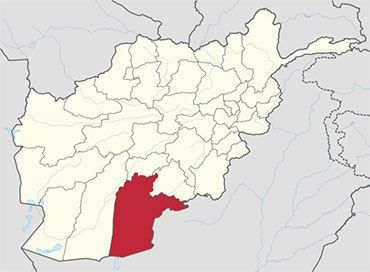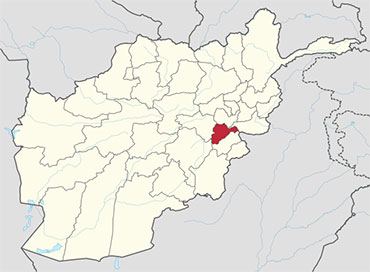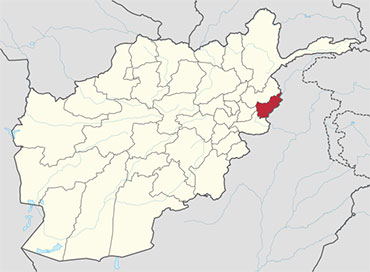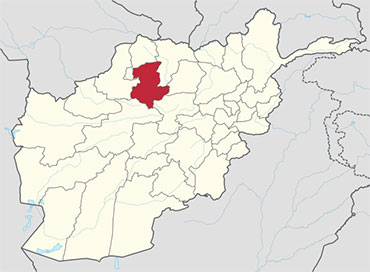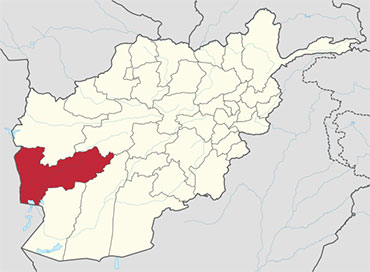 Farah is one of the 34 provinces of Afghanistan, located in the western part of the country next to Iran. It is a spacious and sparsely populated province, divided into eleven districts and contains hundreds of villages. It has a population of about 925,016, which is multi-ethnic and mostly a rural tribal society. The Farah Airport is located near the city of Farah, which serves as the capital of the province.Geographically the province is approximately 18,000 square miles (47,000 km2), making it (comparatively) more than twice the size of Maryland, or half the size of South Korea. The province is bounded on the north by Herat, on the northeast by Ghor, the southeast by Helmand, the south by Nimroz, and on the west by Iran. It is the fourth largest province in Afghanistan. The province is home to a great many ruined castles including the “Castle of the Infidel” just south of Farah City.
Farah is one of the 34 provinces of Afghanistan, located in the western part of the country next to Iran. It is a spacious and sparsely populated province, divided into eleven districts and contains hundreds of villages. It has a population of about 925,016, which is multi-ethnic and mostly a rural tribal society. The Farah Airport is located near the city of Farah, which serves as the capital of the province.Geographically the province is approximately 18,000 square miles (47,000 km2), making it (comparatively) more than twice the size of Maryland, or half the size of South Korea. The province is bounded on the north by Herat, on the northeast by Ghor, the southeast by Helmand, the south by Nimroz, and on the west by Iran. It is the fourth largest province in Afghanistan. The province is home to a great many ruined castles including the “Castle of the Infidel” just south of Farah City.
History
Shahr-e Kohn-e (“Old City”) or Fereydun Shahr (“City of Fereydoon”) is located in Farah city. This ancient city is more than 3000 years old. It was one of the ancient places of the Persian kings, as Farah belonged historically to the Sistan empire. The name “Fereydun” here refers to a hero of the Persian epic Shahnameh.
The territory was known around 500 BC as Drangiana, with Arachosia being to the east and Ariana to the north. It was part of the Median Empire followed by the Achaemenids. In 330 BC Alexander the Great took possession of the land and made it part of his empire. Upon Alexander’s untimely death in 323 BC the region, along with the rest of his vast empire, was fought over by his generals all vying to be his successor. Eventually several of these were successful in carving out parts of Alexander’s empire for themselves thereby becoming his official successors or Diadochi. One of these generals, Seleucus, made this region part of his domain giving it his name as the Seleucid Empire. They were replaced by other rulers and the area eventually fell to the Sassanids, then to the Arab Muslims. The Saffarids rose to power in 867 AD in Zaranj and made Farah part of their empire. By the 10th century the province became part of the Ghaznavid Empire, whose capital was located in Ghazni. They were replaced by the Ghurids and then after a century later the area saw the Mongol invasion.
The province was taken by Timur and eventually fell to the Safavid dynasty. It had been lost by the Safavids to the Uzbeks of Transoxiana, but was regained following a Safavid counter-offensive around 1600 CE, along with Herat and Sabzavar.[3] In 1709, the Afghans gained independence from the Safavids and Farah became part of the Hotaki Empire. By 1747, it became part of Ahmad Shah Durrani’s last Afghan empire. During the 19th century, the British army passed through the province to support Afghan forces in Herat Province against the invading Persians.
Following the Marxist revolution in 1978, Farah was one of the cities in which civilian massacres were carried out by the now-dominant Khalqi communists against their political, ethnic, and religious opponents. At the start of the 1980s, the majority of Farah was allied with the Harakat-i-Inqilab-i-Islami movement, but after 1981 the province split along linguistic lines, with Pashtun-speaking opponents of the communist government remaining with Harakat, and Dari speakers moving to the Jamiat-e Islami.
Following the 1992 collapse of the communist-backed Democratic Republic of Afghanistan, Farah Province, like Herat, Nimroz, and Badghis provinces, came under the influence of Herat-based powerbroker Ismail Khan. As the Taliban came to power, they sparred with Ismail Khan over Farah Province, as his occupation of the province and the strategic Shindand Airfield in its south stymied their efforts to seize Herat. The Taliban employed human wave tactics in an attempt to overtake the airfield.
A 1995 Oxfam report lists Farah as “severely mined”, and indicated that Farah was particularly problematic due to the wide variety of mine devices employed there, as well as usage of mines to deny access to irrigation systems.[6] By late 1995, the stalemate broke as the Taliban counterattacked after Ismail Khan’s failed drive to Kandahar, and all of Farah fell as the Taliban swept to take Herat on 5 September 1995.
Recent History
Due to its isolation from the Taliban’s area of focus, Farah exerted some small level of local control during Taliban rule. By the end of the Taliban period, there were eight United Nations Development Program (UNDP) schools, for both boys and girls, recognized and supported by the Taliban in Kandahar and Farah. UNDP noted that the local authorities in Farah were “particularly cooperative” on the subject.
Following the Coalition entry and union with the Northern Alliance after September 11, 2001, the Taliban withdrew from Farah due to the heavy Coalition aerial campaign, though ground troops were not sent to the province until some time later.
Village elders attend the graduation ceremony for the first Afghan local police unit in the Bala Baluk district.
Farah has not seen much fighting since the US backed overthrow of the Taliban in 2001, and is peaceful, relative to many parts of the country. Although there has been sporadic heavy combat in the Bala Baluk, and Gulestan districts. However, mountainous Eastern Farah has seen at least one US offensive against Taliban forces. In February 2005, the Taliban killed an aid worker in northern Farah and there was a failed Taliban assassination attempt on the governor. Due to its proximity to the restive Helmand and Uruzgan provinces, Farah has experienced problems with roaming insurgent gangs moving through the province and occupying parts of the province for brief periods of time. Incidents of this type have increased as Taliban fighters face heavy pressure from the International Security Assistance Force (ISAF) offensives in the south.
The roads in Farah province have seen massive improvement since May 2005 and are still being improved to date April 2006. The education system has been greatly improved and a great number of illegal weapons have been collected and destroyed in the province as testimony to the Provincial Reconstruction Team. The United States built a base at Farah Airport, which is being expanded and also houses the Afghan National Security Forces (ANFS).
In May 2009, an American airstrike in the village of Granai in Bala Buluk District occurred that killed a large number of civilians. According to the New York Times, the villagers said that 147 were killed, an independent Afghan human rights group put the number of killed at 117. The Americans claimed the airstrike was targeting Taliban militants, but villagers said that the Taliban had left by the time the airstrike occurred.[11] On May 19, the U.S. Ambassador to Afghanistan Karl Eikenberry visited Farah town to talk with the survivors. He promised that “the United States will work tirelessly with your government, army and police to find ways to reduce the price paid by civilians, and avoid tragedies like what occurred in Bala Baluk.
Economy
Farah’s economy is overwhelmingly agricultural. The province has minerals such as gypsum, lime and construction stones, gold’s coal and uranium. 1300 worker were employed by manufacturing firms in the province. 74% of rural households reported either agriculture or livestock to be their main source of income and 24% reported that trade and service (including non-farm labor) to their main source of income.
Healthcare
The percentage of households with clean drinking water increased from 3% in 2005 to 14% in 2011.[15] 6% of births were attended to by a skilled birth attendant in 2011.
Demographics
The total population of Farah province is about 925,016, which is predominately tribal and a rural society. About 482,400 are settled while the remaining are the Kuchi and other nomads. The ethnic Pashtuns make up 80% of the population, with Baloch being 14%, and the remaining 6% are Tajiks, Aimak and Hazara. The primary Pashtun tribes in Farah province are the Alizai, Barakzai, and Nurzai. However, the Kuchi nomads, a Pashtun group, make up almost 17% of the population, in winter, but only 2% in the summer.
All inhabitants follow Islam, 95% are Sunni while 5% are Shias.[16] As of 2005, the languages spoken in the province were Dari (50%), Pashto (48%), and Balochi a distant third being spoken in only four villages.[18] Multilingualism is common throughout the region.
Districts
Farah province is divided in to 11 districts.
| Province | Population | Area |
|---|---|---|
| Anar Dara | 65,573 | 5,000 km2 |
| Bakwa | 39,871 | 2,424 km2 |
| Bala Buluk | 72,465 | km2 |
| Farah | 104,300 | 3,500 km2 |
| Gulistan | 49,774 | 7,102 km2 |
| Khaki Safed | 37,000 | 1,200 km2 |
| Lash Wa Juwayn | 20,499 | 5,491 km2 |
| Pur Chaman | 51,626 | 6,694 km2 |
| Pusht Rod | 37,000 | 1,200 km2 |
| Qala-I-Kah | 30,653 | 3,598 km2 |
| Shib Koh | 23,013 | 2,738 km2 |
